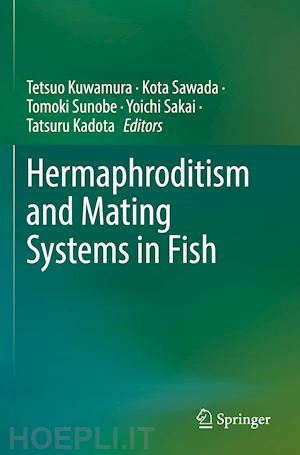
Questo prodotto usufruisce delle SPEDIZIONI GRATIS
selezionando l'opzione Corriere Veloce in fase di ordine.
Pagabile anche con Carta della cultura giovani e del merito, 18App Bonus Cultura e Carta del Docente
This book provides a comprehensive review of hermaphroditism in fishes. It focuses on the behavioral ecology of functional hermaphroditism in fishes and discusses its evolution.
Approximately 99% of all vertebrate species consist of separate-sex individuals (gonochorists), i.e., pure males and pure females. The other 1% of vertebrate species are hermaphroditic, and almost all of them are fishes. Among hermaphroditic fishes, four major types of hermaphroditism are known: simultaneous (or synchronous) hermaphroditism, protandry (male-to-female sex change), protogyny (female-to-male sex change), and bidirectional sex change (or reversed sex change in protogynous species).
The book examines the occurrence of hermaphroditism in relation to phylogeny and mating systems. It also reviews the hypotheses for the evolution of hermaphroditism, and the size-advantage model, which is the main theory for the evolution of sex change, tested in relation to the mating system. The appendix in the last chapter provides an annotated list of hermaphroditic fish species (ca. 500 spp.).
Chapter 1. Evolution of hermaphroditism in fishes: phylogeny and theory.- Chapter 2. Simultaneous hermaphroditism in fishes.- Chapter 3. Protandry in fishes.- Chapter 4. Protogyny in fishes.- Chapter 5. Bidirectional sex change in fishes.- Appendix 1. Database of hermaphroditic fish species.- Appendix 2. References of hermaphroditic fish species cited in Appendix 1.
Kota Sawada is a scientist at Fisheries Resources Institute, Japan Fisheries Research and Education Agency. He received his Ph.D. in Science from SOKENDAI (The Graduate University for Advanced Studies) in 2016. He has been conducted empirical and theoretical studies on the evolution of sexual systems among fishes and barnacles. He has also been engaged in the studies on biology and fisheries managements of demersal fishes exploited in the high seas. Ichthyological Research Best Article Award 2021 for a paper entitled "Hermaphroditism in fishes: an annotated list of species, phylogeny, and mating system" by Kuwamura T, Sunobe T, Sakai Y, Kadota T, and Sawada K (2020. Ichthyological Research, 67:341–360).
Tomoki Sunobe is a professor at Field Science Center, Tokyo University of Marine Science and Technology. He received his Doctor of Agriculture from Kyushu University in 1990. He has been studying on mating system, sex change, endocrinology and phylogeny of hermaphroditic gobiid fishes. He also has conducted field observations on reproductive ecology of various taxa of fishes like Muraenidae, Labridae, Platycephalidae and Pomacentridae in Tateyama, Chiba, Blenniidae and Serranidae in Kagoshima, Japan, and Cichlidae in Lake Tanganyika, East Africa. Zoological Science Award 2005 for a paper entitled “Characterization of two types of cytochrome P450 aromatase in the serial-sex changing gobiid fish, Trimma okinawae“ by Kobayashi Y, Kobayashi T, Nakamura M, Sunobe T, Morrey CE, Suzuki N, and Nagahama Y (2004. Zoological Science, 21: 417-425).
Yoichi Sakai is a professor at Hiroshima University. He received his Doctor of Science from Osaka City University in 1996. He has conducted behavioral ecology studies of marine fishes in a variety of fish taxa, based on field observations on reefs of Kuchierabu-jima Island, Kagoshima, and Okinawa. Life history tactics including sex change, mating systems, and foraging ecology are central topics of his research teams. The Best Article Award of the Ichthyological Society of Japan in 2019 and 2021: “Redescription of the bump-head sunfish Mola alexandrini (Ranzani 1839), senior synonym of Mola ramsayi (Giglioli 1883), with designation of a neotype for Mola mola (Linnaeus 1758) (Tetraodontiformes: Molidae)” (2018. 65:142–160) and “Hermaphroditism in fishes: an annotated list of species, phylogeny, and mating system” (2020. Ichthyological Research, 67:341–360).Tatsuru Kadota is a senior scientist at Fisheries Technology Institute, Japan Fisheries Research and Education Agency. He received his Doctor of Agriculture from Hiroshima University in 2009. He has been studiing mating system and sex change of reef fishes. He has also been engaged in the studies on ecology of herbivorous fishes and macroalgae to restore macroalgal beds in southern Japan. Ichthyological Research Best Article Award 2021 for a paper entitled "Hermaphroditism in fishes: an annotated list of species, phylogeny, and mating system" by Kuwamura T, Sunobe T, Sakai Y, Kadota T, and Sawada K (2020. Ichthyological Research, 67:341–360).











Il sito utilizza cookie ed altri strumenti di tracciamento che raccolgono informazioni dal dispositivo dell’utente. Oltre ai cookie tecnici ed analitici aggregati, strettamente necessari per il funzionamento di questo sito web, previo consenso dell’utente possono essere installati cookie di profilazione e marketing e cookie dei social media. Cliccando su “Accetto tutti i cookie” saranno attivate tutte le categorie di cookie. Per accettare solo deterninate categorie di cookie, cliccare invece su “Impostazioni cookie”. Chiudendo il banner o continuando a navigare saranno installati solo cookie tecnici. Per maggiori dettagli, consultare la Cookie Policy.